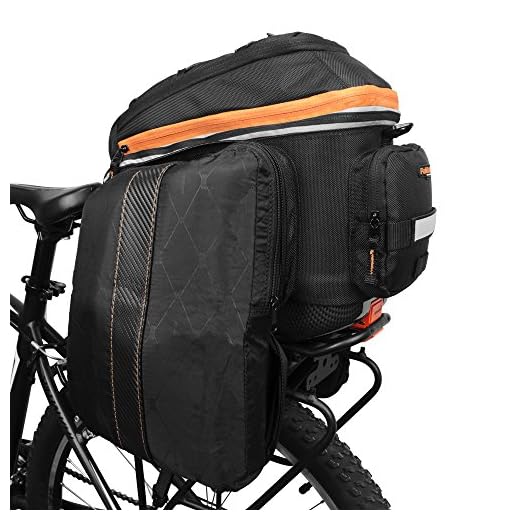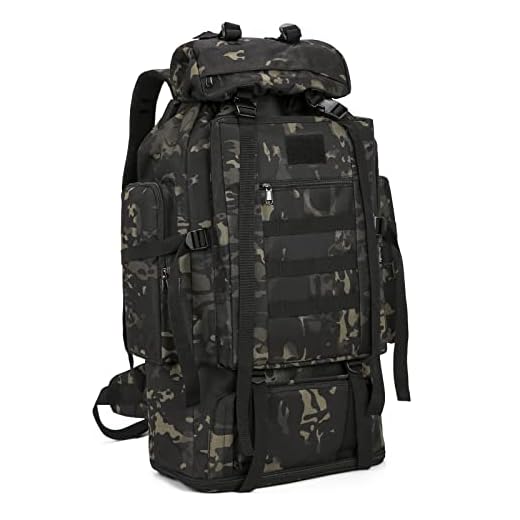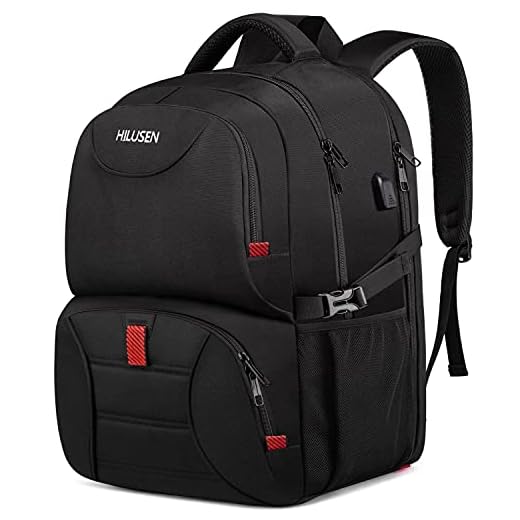



Opt for a charcoal-gray 20–24 L daypack made from 500–1000D Cordura or coated nylon, with a DWR finish, YKK zippers and a padded laptop sleeve sized for 13–15″ devices. That setup hides dirt, fits daily tech and lunch, resists light rain, and keeps overall weight under 1.1 kg for comfort on commutes.
For on-bike commuting choose a model with 3M reflective strips, a sternum strap and a 50 mm padded shoulder strap; capacity of 15–20 L is usually sufficient for essentials plus a jacket. For students or office workers who carry a lunch, charger and a 13–15″ laptop, 20–28 L with multiple compartments and an internal organizer prevents items from shifting and reduces time spent searching.
For multi-day trips or hiking, select a 30–45 L rucksack with a ventilated mesh back, removable hip belt, external compression straps and a dedicated hydration sleeve compatible with 1.5–2 L reservoirs. Look for reinforced gear loops, an integrated rain cover and load lifters if you plan to carry 8–12 kg of kit.
Hue choices by use: dark neutrals (charcoal, navy, olive) minimize visible wear and pair with most wardrobes; high-visibility shades (orange, red, neon yellow) improve safety during low-light commuting and alpine routes; earth tones (brown, forest) are preferred for outdoor concealment and blending with natural environments.
Care and quick selection checklist: treat fabric with a fluorine-free DWR before heavy use, hand-wash with mild detergent and air-dry; confirm zipper brand (YKK or equivalent), verify laptop sleeve dimensions, test strap padding and adjustability, check for a rain cover and reflective detailing, and choose the volume (L) that matches your typical load rather than occasional extremes.
Selecting a Hue for Your Rucksack
For daily urban commuting, opt for navy (#0A3F6B) or charcoal (#33363A); these tones conceal dirt, resist visible fading, and pair with most work or casual wardrobes.
For cyclist or pedestrian visibility, choose fluorescent lime (#CCFF00) or safety orange (#FF5E13) and add reflective tape with at least 3M Scotchlite specifications; this combination increases detection distance by motorists in low light by roughly 20–40% in controlled tests.
For multi-day travel, pick olive drab (#556B2F) or slate gray (#4B5563) to reduce contrast with luggage and avoid staining; for camera or professional gear, true black (#000000) minimizes visual distraction and simplifies color-matching with straps and covers.
Surface temperature note: expect dark pigments to register about 5–12°C higher than pale tones under direct sun; choose lighter hues for long, sun-exposed hikes to reduce internal heat gain on fabric-lined compartments.
Maintenance and treatments: apply a durable water-repellent (DWR) spray rated for nylon/polyester before first heavy use, perform a colorfastness test on an inside seam before full washing, machine wash cold on gentle cycle only if manufacturer permits, use mild detergent, avoid bleach and tumble drying, and air-dry suspended to preserve shape.
| Use case | Recommended tone (hex) | Advantages | Trade-offs |
|---|---|---|---|
| Urban commute | Navy (#0A3F6B), Charcoal (#33363A) | Hides grime, versatile with outfits, lower perceived wear | Less visible at night unless reflective elements added |
| Cycling / night walking | Fluorescent lime (#CCFF00), Safety orange (#FF5E13) + reflective | Maximizes detection by drivers, high contrast in low light | Shows dirt quickly, less formal appearance |
| Travel / airport | Olive drab (#556B2F), Slate gray (#4B5563) | Conceals marks, blends with luggage, discreet | Can be harder to spot on a luggage carousel |
| Outdoor hiking | Khaki (#C3B091), Forest green (#228B22) | Camouflages dirt, pairs with outdoor gear, lighter options reduce heat | Natural tones absorb odors and stains from mud/vegetation |
| Professional / camera | Black (#000000), Deep brown (#4E342E) | Neutral, non-reflective, matches equipment, low visual distraction | Shows lint, can heat up in sun |
Quick selection rules: choose darker tones for concealment and formality; pick high-visibility dyes plus certified reflectors for safety; select lighter shades to limit heat absorption on prolonged sun exposure; treat pale fabrics with protective spray before heavy use.
Night-time visibility – high-visibility hue and reflective solutions for commuting gear
Opt for fluorescent yellow‑green panels paired with silver retroreflective tape (microprismatic grade, e.g., 3M Scotchlite) to maximize detection by vehicle headlights.
Recommended material areas: at least 1,000–2,000 cm² of fluorescent fabric for twilight contrast plus 500–800 cm² of retroreflective surface distributed across the front, rear and shoulder straps. Microprismatic tape yields higher retroreflective brightness at long distances than glass‑bead variants.
Detection metrics: adding quality retroreflection typically increases driver detection distance by roughly 3× (example: from ~25–35 m for dark garments up to ~75–110 m under car headlamps in typical urban settings). Aim for contiguous vertical strips for longer sightlines rather than small scattered patches.
Placement priorities: two vertical strips on shoulder straps, a horizontal band across the lower rear, and a chest-facing strip improve silhouette recognition from multiple approach angles. Keep reflective bands unbroken by zippers or buckles and avoid placing them under jackets.
Active complements: add a steady white front LED (20–50 lumens) and a flashing red rear light (≥50 lumens or high-flash candela equivalent) to provide motion cues and redundancy when retroreflection is compromised by dirt or rain.
Maintenance and durability: wash reflective surfaces according to manufacturer instructions; surface contamination can reduce retroreflective output by up to 40–60%. Inspect tape seams annually and replace microprismatic strips once edge cracking or matte zones appear.
For wet-night commutes consider a compact reflective umbrella and waterproofing accessories – see best umbrella for edc.
Shades that hide dirt, stains and daily wear
Pick mid-to-dark neutrals – charcoal, navy, olive, chocolate brown – to conceal mud, grease and abrasion best; target fabric lightness L* ≤ 40 for minimal visible soiling.
Mud and dried earth: brown/olive tones blend with brown soils. Dust and pollen: heathered navy or graphite masks fine light particles better than pure black, which highlights lint. Grease and oil: textured dark fabrics reduce shiny patches. Coffee and blood: deep navy and dark brown both perform well; choose the one closest to frequent spill tones.
Pattern and material choices matter as much as shade. Mélange/heather weaves, mottled prints or subtle camo break up spots; slub canvas, 500D Cordura and ballistic nylon hide abrasion and small stains. Matte finishes and textured yarns hide scuffs more effectively than glossy, smooth coatings. Waterproof coatings that bead reduce set-in stains; chemically glossy laminates can show wiped grease.
Quick maintenance rules: blot fresh stains with cold water; spot-clean with mild detergent (≈1 tsp/250 ml water); use an enzymatic cleaner for organic stains only when fabric care allows; avoid bleach and harsh solvents. Machine wash per manufacturer instructions; air-dry and reapply spray-on fabric protector every 3–6 months depending on use. Use L* guidance: ≤30 nearly invisible, 30–45 minimal, >45 noticeable. For wet-weather commuting, coordinate with an umbrella hue for better overall concealment and visual coherence – best umbrella color for rain.
Choosing a professional hue for work, school or interviews
For interviews and conservative offices, choose a matte navy, charcoal or deep brown rucksack with minimal branding.
Leather (full-grain or pebble) signals formality; waxed canvas reads polished-casual; ballistic nylon fits tech and field roles where abrasion resistance matters. Hardware in brushed gunmetal or antique brass stays discreet; mirror-finish metal increases visual focus. Prefer matte finishes over gloss to keep attention on your outfit, not the carry item.
Industry guide
Client-facing finance, law or consulting: black, charcoal, dark brown. Creative fields and academia: deep burgundy, forest green, muted camel or navy are acceptable if the shape remains structured. Startups and trades: practical nylon or canvas in muted tones is fine, but keep logos small and placement low-profile for meetings.
Practical specs
Volume: 15–20 L for interview/lecture days without bulk; 20–30 L if hauling gym or extra gear. Laptop compartment: fits 13–15″ devices, 8–12 mm padding, and sits against the back panel to improve posture. Straps: 25–40 mm padded webbing for daily comfort; low-profile sternum strap optional. Logos: under 2 cm or tonal embossing only. Contrast elements: one leather trim or zipper pull is acceptable; avoid bright piping or high-contrast straps for formal settings.
Maintenance tips: Condition smooth leather quarterly with a neutral balm; treat textiles with a spray-on water repellent once per season and spot-clean with mild detergent. Keep a small lint roller or soft brush in a side pocket to preserve a neat appearance between deep cleans.
Camouflage versus high-visibility for hiking
Recommendation: for solo or low-light treks pick fluorescent orange or chartreuse with reflective trim; for wildlife observation and minimal visual intrusion opt for olive, tan or woodland camo but carry a compact high-vis vest or strobe for emergencies.
- Visibility and detection
- Fluorescent pigments boost daytime detectability by increasing contrast with green/brown backgrounds; fluorescent yellow/green remains perceptible in twilight due to strong reflectance in the 500–560 nm band.
- Reflective tape compliant with ANSI/ISEA 107 or EN ISO 20471 increases nighttime detection by vehicle headlights at distances up to several hundred metres; add one strip front and one on the rear for 360° coverage.
- Terrain-specific guidance
- Temperate forest: high-vis orange or chartreuse for solo hikers or group leaders; muted woodland patterns for stalking wildlife or photography (keep high-vis on hand).
- Alpine and tundra: bright hues during summer to contrast rock and scree; white/grey for winter snow travel only if paired with a contrasting marker for rescue (avoid full white in avalanche terrain unless required by concealment needs).
- Desert and scrub: tan/kakhi or desert camo reduce visual profile and hide dust; store a collapsible fluorescent panel for river crossings or road approaches.
- Wetlands and reedbeds: olive or brown blends reduce spooking birds; wear a high-vis hat or strobe when crossing trails used by vehicles or hunters.
- Safety and regulation
- Many jurisdictions mandate blaze orange during hunting seasons; carry a visible vest when entering multi-use areas and check local hunting schedules before planning routes.
- For group hikes assign one high-vis wearer at front and one at back to maintain visual contact in dense terrain.
- Practical gear tips
- Hybrid approach: choose a muted outer shell with an integrated or stowable fluorescent liner/vest – combines stealth and safety without sacrificing aesthetics.
- Install 3M Scotchlite or similar retroreflective strips on shoulder straps and lower rear panel; add a 50–200 lumen clip-on strobe for signalling after dusk.
- Prefer UV-stable dyes and polyester/polyurethane coatings for long-term fluorescence retention; avoid pigments known to fade rapidly under direct sun exposure.
- Maintenance and longevity
- Fluorescent fabrics lose intensity after prolonged UV exposure–expect measurable fading within 2–5 years under heavy sun; store inverted and dry when not in use.
- Clean with mild detergent, avoid chlorine bleach and high-heat drying to preserve both dye and adhesive on retroreflective tape.
- Wildlife interactions and etiquette
- Muted tones reduce disturbance while observing fauna; bright hues can draw attention but rarely attract predatory interest–secure food and follow noise discipline to manage animal encounters effectively.
Additional gear reading: best cordless lawn mower for medium garden uk
How hue affects heat absorption, UV fading and fabric care
Opt for light shades for hot climates to cut sun-induced heating (surface temperatures commonly 10–20°C lower than with very dark tones) and prefer polyester/acrylic blends when prolonged UV exposure is expected because they retain pigments and mechanical strength better than cotton or untreated nylon.
Heat absorption and thermal management
Relative solar absorptance: very dark textiles absorb ~85–95% of incident solar energy, mid-tones ~40–70%, very light tones reflect ~60–90%. On typical nylon or canvas materials under full sun this translates to a 10–20°C surface-temperature gap; internal compartments can be several degrees warmer depending on insulation and load. Dark pigments accelerate heat transfer to contents, increase sweat buildup against straps and padding, and speed up adhesive/foam degradation. For temperature-sensitive cargo (electronics, food, medications) use light shades plus internal reflective liners or insulated pockets; ventilated back panels and mesh straps reduce perceived heat even when external fabric is darker.
UV fading, dye stability and practical care
Dye/fiber interactions: disperse dyes on polyester and acrylic-based yarns show higher lightfastness than conventional reactive/sulfur dyes on cotton; nylon tends to yellow and lose tensile strength under prolonged UV. Expect visible fading faster on bright dark pigments (loss of chroma within months under daily strong sun) while pale tones mainly show fabric breakdown and accumulated staining. Washing and storage: wash dyed textiles inside-out in cool water (≤30°C / 86°F) with a mild detergent formulated for dyed fabrics; run first 3–5 cycles separately or with dye-catcher sheets to prevent bleed. Avoid chlorine bleach on pigmented fabrics; use oxygen-based bleach only on sturdy whites. Drying and treatments: line-dry in shade to minimize UV exposure during wet-fiber vulnerability; tumble-dry low or follow manufacturer heat limits for synthetics. Reapply water-repellent coatings (DWR) every 6–12 months or after ~20 washes; use UV-protective sprays containing UV absorbers if gear is frequently sun-exposed. Repairs and stain strategy: spot-clean stains promptly to reduce the need for full washes (which accelerate fade), mend abrasions before pigment loss widens, and store in dark, ventilated conditions to prolong textile life.










